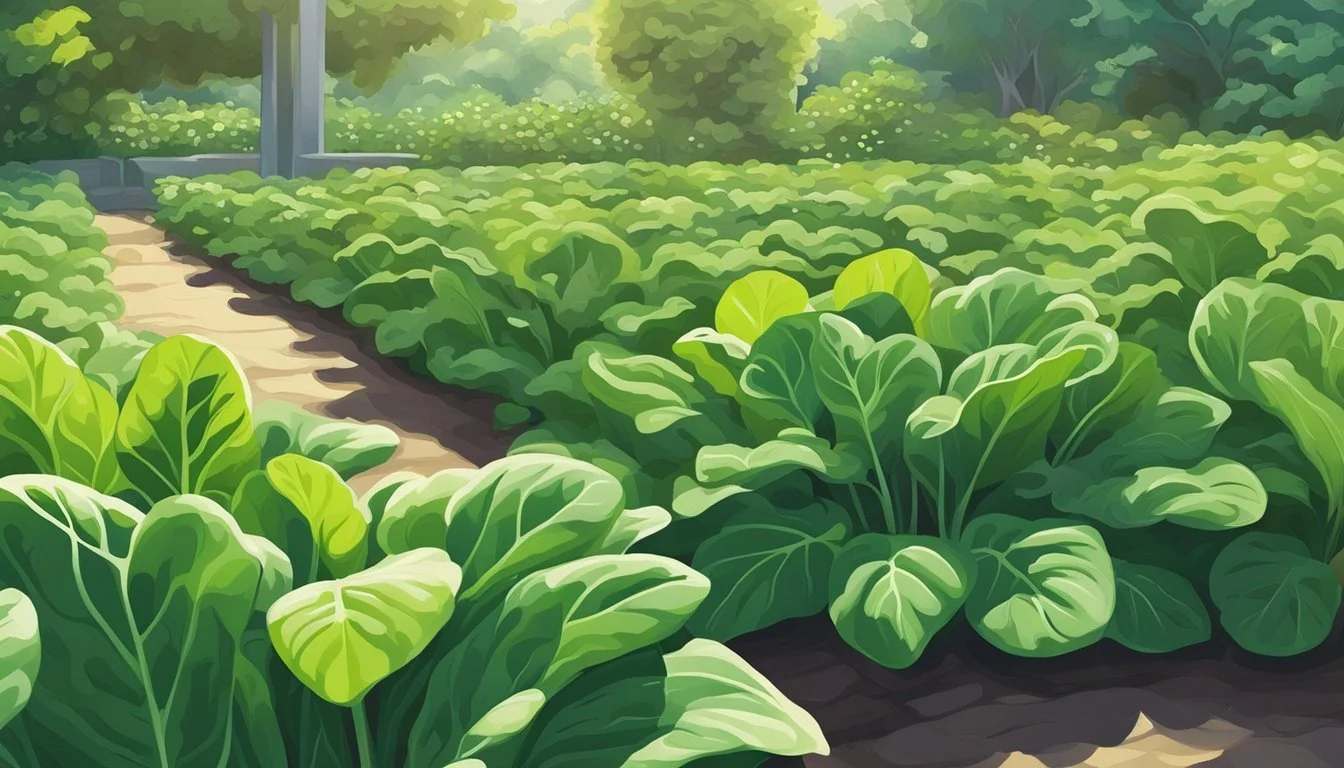Okinawan Spinach Substitutes
Top Alternatives for Your Recipes
Okinawan spinach, also known as Gynura bicolor, is a versatile and nutritious leafy green, prized for its unique flavor and vibrant appearance. Often used as a ground cover in tropical and subtropical climates, this perennial plant features striking leaves that are green on top and purple underneath. Not only is it edible and packed with health benefits, but it also serves as an excellent companion plant in gardens.
For those looking for substitutes for Okinawan spinach in their recipes, several alternatives are available that maintain similar nutritional benefits and culinary applications. Malabar spinach, Brazilian spinach, and kale are popular choices due to their comparable textures and flavors. These substitutes are ideal, whether used in salads, stir-fries, or as a leafy green addition to various dishes.
Another noteworthy option is Swiss chard, offering a slightly different taste but similar culinary flexibility. As an edible and medicinal herb, Okinawan spinach's substitutes ensure that your meals remain both delicious and healthful, even when the original plant is unavailable.
Understanding Okinawa Spinach
Okinawa spinach, a perennial plant, is admired for its unique characteristics, nutritional richness, health benefits, and ease of cultivation in tropical and sub-tropical regions.
Characteristics of Okinawa Spinach
Okinawa spinach (Gynura bicolor) features vibrant green leaves with purple undersides. This leafy green is native to Southeast Asia and flourishes as an edible ground cover. It grows well in both full sun and partial shade, adapting to various indoor and outdoor environments.
Known also as Okinawa lettuce, it can be grown from cuttings, and its resilience makes it popular among gardeners. Proper soil conditions and regular pruning ensure lush, dense growth, which can also be used ornamentally.
Nutritional Profile
Okinawa spinach is a nutritious addition to any diet. It is packed with vitamins A and C and is a good source of iron and calcium. This leafy green also provides essential antioxidants and dietary fiber. Here’s a quick overview of its primary nutrients:
Nutrient Amount per 100g Vitamin A 5700 IU Vitamin C 45 mg Iron 2.2 mg Calcium 130 mg
Including Okinawa spinach in meals supports overall nutritional intake, contributing to a balanced diet.
Health Benefits
The health benefits of Okinawa spinach are numerous. It is known for promoting eye health due to its high vitamin A content. The vitamin C in the leaves boosts immune function and skin health. Its antioxidants help reduce inflammation and may protect against chronic diseases.
Regular consumption can aid digestion because of its fiber content. Additionally, the plant’s compounds have shown potential for maintaining cardiovascular health and supporting healthy blood pressure levels.
Growing Okinawa Spinach at Home
Growing Okinawa spinach at home is straightforward and rewarding. This perennial plant thrives in well-drained, fertile soil with a slightly acidic to neutral pH (6.0-7.0). It can be started from seeds or cuttings and prefers a warm, humid environment.
Plant cuttings about 1-2 feet apart, allowing space for them to spread as ground cover. Water consistently to keep the soil moist but not waterlogged. Mulching helps retain soil moisture, which is crucial for healthy growth.
Okinawa spinach can be grown in containers or directly in garden beds, making it versatile for various gardening spaces. Pruning regularly encourages dense foliage and provides a continual harvest of fresh leaves.
Best Okinawa Spinach Substitutes
For those unable to find Okinawa spinach, several other leafy greens can serve as excellent substitutes. These alternatives vary in taste, texture, and resilience to heat, meeting a variety of culinary needs.
Using Common Spinach as a Substitute
Common spinach is readily available and easy to incorporate into dishes. Its mild flavor makes it versatile in recipes like salads, stir-fries, and smoothies.
When using common spinach, note that it wilts quickly when cooked, similar to Okinawa spinach. Ensure to add it towards the end of cooking to maintain some texture. This green is also rich in vitamins A and C.
Malabar Spinach for Texture and Heat Resistance
Malabar spinach is another great substitute due to its thick leaves and heat tolerance. Unlike common spinach, Malabar spinach retains its texture better when cooked, making it suitable for stir-fries and soups.
Its slightly mucilaginous texture can be a unique addition to salads and smoothies. This leafy green thrives in hot climates and can be grown as a perennial, much like Okinawa spinach.
Mustard Greens for a Peppery Taste
Mustard greens offer a distinct peppery flavor that can add a spicy kick to dishes. They are perfect for those who enjoy a bit of heat in their salads and cooked dishes.
These greens are not as tender as spinach but provide a similar nutrient profile, including vitamins K, A, and C. When cooking mustard greens, blanching them first can help reduce bitterness.
Swiss Chard as an Alternative
Swiss chard is another nutritious substitute with slightly tougher leaves than spinach. The stem can be removed to reduce bitterness and enhance the texture in dishes.
Its earthy flavor pairs well with salads, stir-fries, and even smoothies. Growing Swiss chard is manageable in various climates, and it maintains its nutritional value when cooked, making it a reliable alternative to Okinawa spinach.
Preparing Spinach Substitutes
Spinach substitutes like kale, Swiss chard, arugula, and collard greens can be prepared in various ways to fit a range of dishes. Proper preparation techniques ensure these substitutes maintain their nutrients and match the desired textures and flavors of your recipes.
Cooking Greens in Diverse Ways
Cooking leafy greens like kale, Swiss chard, and arugula can be done through methods such as steaming, stir-frying, and sautéing.
Steaming is ideal for preserving nutrients and color. It works well for collard greens and Swiss chard, offering a tender yet firm texture.
Stir-frying provides a quick cooking method that enhances flavors. Arugula and Swiss chard can be quickly stir-fried with garlic and olive oil for a flavorful side dish.
Sautéing kale with onions and spices can be a delicious and nutrient-packed option. This method is versatile, adding layers of taste to the greens.
Maintaining Nutrient Integrity
Preserving the nutritional value of spinach substitutes requires careful cooking techniques.
Steaming and quick blanching are effective methods to retain vitamins and minerals. These methods keep the greens' vibrant color and nutritional quality intact. Avoid overcooking which can deplete essential nutrients.
Inclusion in salads ensures that all nutrients are maintained without any loss. When adding to soups or stir-fries, cooking time should be minimized. This approach maintains both the nutrient integrity and the fresh taste.
Adjusting Textures and Flavors
Different textures and flavors can be achieved by adjusting the cooking methods.
For a crunchy texture, briefly stir-fry kale or collard greens. This method allows for a crispy bite while keeping flavors intact.
For a softer texture, slow-cooking greens such as Swiss chard in broths or stews achieves a tender consistency.
Adjust flavors by using seasonings, herbs, and spices according to the dish. For example, lemon juice adds brightness to steamed greens, while garlic and chili flakes create a robust flavor in sautéed greens. This tailoring ensures the greens fit into various culinary contexts.
Gardening Tips for Spinach Varieties
Spinach thrives with specific care for soil, water, and harvest timing. Understanding these factors ensures a healthy and productive garden.
Optimal Soil Conditions
Spinach varieties prefer soil that is rich, loose, and well-draining. A neutral pH between 6.5 and 7.0 is ideal.
Fertile soil is necessary for healthy plant growth. Adding organic matter such as compost can enhance soil quality. While typical spinach loves cool weather, growing some varieties like Okinawa spinach can also be successful in sub-tropical climates.
Raised beds or containers work well for maintaining control over soil quality and drainage. Ensure your containers have holes to allow excess water to escape, preventing root rot.
Watering Requirements
Proper watering is crucial for spinach growth. Spinach plants require consistent moisture but not waterlogged soil.
It’s best to water the plants early in the morning to reduce evaporation and risk of fungal diseases. Spinach prefers sandy loam soil, which offers good drainage but retains enough moisture.
For Okinawa spinach, maintaining even soil moisture is key since it thrives in humid environments. In containers or windowsill gardens, make sure the water reaches the roots without soaking them, potentially leading to rot.
When to Harvest
Knowing when to harvest spinach is essential for the best taste and yield. Spinach is typically ready to harvest within 37 to 45 days after planting, depending on the variety.
Okinawa spinach, a perennial, can be harvested continuously once established. For young leaves, pick when they are about 3-4 inches long for the freshest flavor. Regular harvesting encourages new growth, ensuring a steady supply.
Cut leaves with scissors to avoid damaging the plant base. Removing outer leaves while leaving the inner ones will allow the plant to continue growing.
This section covers the essential tips for growing spinach, including soil preparation, watering, and the right time to harvest, ensuring a thriving spinach garden.
Health and Dietary Considerations
When choosing substitutes for Okinawan spinach, it's important to evaluate the nutritional benefits and dietary restrictions that may influence one's diet.
Nutrient Content Comparison
Different leafy greens offer varying levels of essential nutrients. For instance, kale is a strong contender due to its high iron, vitamin K, and antioxidants content. These nutrients support blood health and have anti-inflammatory properties.
Okinawan spinach contains dietary fiber essential for digestion and aiding in weight management. It is also beneficial for blood sugar balance and has potential benefits for individuals with diabetes due to its significant fiber content.
In terms of calcium and potassium, both essential for bone health and muscle function, spinach itself is a reliable source, whereas kale offers a slightly higher content of calcium. The vitamin A in many leafy greens supports liver health and vision, making these vegetables a comprehensive choice for nutritional needs.
Dietary Restrictions and Leafy Greens
Leafy green substitutes must be evaluated based on dietary restrictions. For instance, individuals with hypothyroidism should be cautious with kale and other cruciferous vegetables due to their potential effect on thyroid function.
When it comes to protein content, some greens like Swiss chard provide a decent amount, complementing diets where high protein intake is necessary.
For those managing cholesterol, both Okinawan spinach and its substitutes like kale can help. These greens contain compounds that help lower cholesterol levels naturally.
Lastly, people with kidney issues should consider the potassium content in these greens, as high levels can be problematic. It's essential to choose substitutes that align with individual health needs while providing balanced nutrients.
Incorporating Substitutes into Landscaping
Incorporating substitutes for Okinawan spinach in your landscaping not only provides a functional edible garden but also enhances the aesthetic appeal of your yard with ornamental and multipurpose plants.
Creating an Edible Landscape
Utilizing substitutes for Okinawan spinach, such as Swiss chard and leafy varieties of lettuce, can help create a vibrant and edible landscape. These substitutes thrive in full sun and fertile soil, growing well alongside flowers to offer both beauty and nutrition. The leaves of these substitutes can be harvested regularly, ensuring a continuous supply for salads and soups.
Maintaining a front yard with edible plants can enhance curb appeal. The diverse colors and textures from plants like Swiss chard can provide a visually appealing alternative to traditional ornamental plants. These plants are not only productive but also blend seamlessly into the overall design of the garden, ensuring that functional and aesthetic goals are met.
Decorative and Functional Ground Covers
Substitutes like creeping thyme and strawberries serve as excellent decorative and functional ground covers. These plants spread via runners, creating a dense cover that helps suppress weeds while also providing edible components. Creeping thyme, with its fragrant foliage, is ideal for sunny areas, whereas strawberries can thrive in both sun and part shade.
These ground covers add a lush, green layer to the landscape, making it more inviting. When planted strategically, they can define pathways or fill spaces between larger plants, ensuring continuous ground coverage. The edible ground cover not only acts as a living mulch but also adds a culinary dimension to the garden layout.
Regional Considerations for Growing Greens
The choice of greens to grow depends significantly on climate, native plant compatibility, and the adaptability of specific varieties like Okinawan spinach. Understanding these factors helps ensure a successful and sustainable garden.
Adapting to Different Climates
Different climates require different strategies for growing greens. In warmer regions, such as Southeast Asia and tropical areas, certain leafy greens like Okinawan spinach thrive due to their heat tolerance and drought resistance.
Frost-free climates are ideal for plants like Okinawan spinach. In contrast, areas that experience colder temperatures should opt for more hardy varieties capable of withstanding frost.
Gardeners in Myanmar, Japan, and other similar regions can maximize their yield by growing greens best suited to their local climate conditions.
Native and Non-native Plant Considerations
When selecting greens to grow, it's crucial to consider whether they are native or non-native to your region. Native plants tend to be more resilient and require less maintenance, making them an excellent choice for beginners.
Non-native plants, such as Okinawan spinach, can be successfully grown with proper care and understanding of their needs. Ensuring they receive the right soil, water, and light conditions is essential for their growth.
Incorporating both native and non-native plants can diversify a garden, providing a wider array of nutritional options and culinary uses.
Sustainable Gardening Practices
Sustainable gardening practices ensure the health and longevity of both plants and the environment. Key methods include composting, organic gardening, pest management, and water conservation.
Composting and Organic Gardening
Composting recycles kitchen scraps and yard waste into nutrient-rich soil. Gardeners can use vegetable peels, coffee grounds, and dry leaves in their compost bins. Turning the compost regularly and maintaining a balance of green and brown materials speeds up decomposition.
Organic gardening avoids synthetic chemicals. Instead, practitioners use natural fertilizers such as compost and manure. The focus is on building healthy soil which, in turn, supports resilient plants.
Natural Pest Management
Natural pest management relies on non-chemical methods to control pests. Introducing beneficial insects like ladybugs and lacewings can help reduce harmful pest populations. Companion planting another strategy, involves growing plants like marigolds alongside crops to deter pests.
Physical barriers such as row covers and insect nets offer protection without harming the ecosystem. Regular monitoring and manual removal of pests further contribute to a balanced garden.
Water Conservation Techniques
Water conservation in gardening is achieved through efficient watering practices. Collecting rainwater in barrels for garden use reduces reliance on municipal water. Drip irrigation systems provide water directly to the plant roots, minimizing evaporation and runoff.
Mulching around plants retains soil moisture and reduces the need for frequent watering. Choosing drought-resistant plants also contributes to overall water savings in the garden. Maintaining healthy soil structure enhances its ability to hold water longer.






